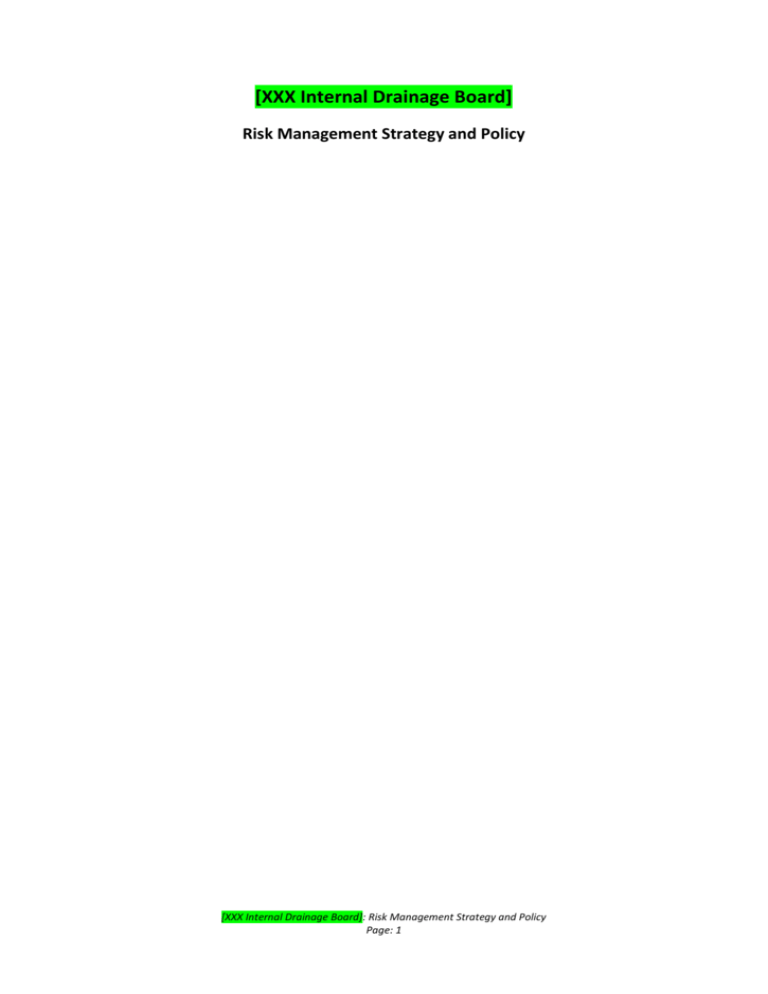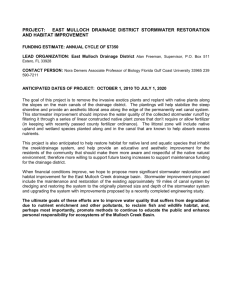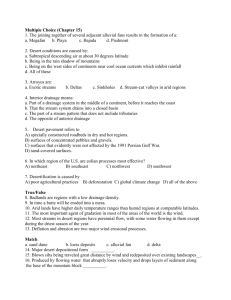Model Risk Management Strategy and Policy
advertisement

[XXX Internal Drainage Board] Risk Management Strategy and Policy [XXX Internal Drainage Board]: Risk Management Strategy and Policy Page: 1 Contents 1. Purpose, Aims & Objectives 2. Accountabilities, Roles & Reporting Lines 3. Skills & Expertise 4. Embedding Risk Management 5. Risks and the Decision Making Process 6. Risk Evaluation and Control 7. Supporting Innovation & Improvement Appendices A – Risk Management Strategy Statement B – Risk Management Policy Document C – Risk Register Format [XXX Internal Drainage Board]: Risk Management Strategy and Policy Page: 2 1. Purpose, Aims and Objectives 1.1 The purpose of the Risk Management Strategy is to effectively manage potential opportunities and threats to the Board achieving its objectives. See attached Risk Management Policy Statement, Appendix A. 1.2 The Risk Management Strategy has the following aims and objectives; Integration of Risk Management into the culture of the Board Raising awareness of the need for Risk Management by all those connected with the delivery of services (including partners) Enabling the Board to anticipate and respond to changing social, environmental and legislative conditions Minimisation of injury, damage, loss and inconvenience to staff, members of the public, service users, assets etc. arising from or connected with the delivery of the Board’s services Introduction of a robust framework and procedures for identification, analysis, assessment and management of risk, and the reporting and recording of events, based on best practice Minimisation of the cost of risk 1.3 To achieve these aims and objectives, the following strategy is proposed; Establish clear accountabilities, roles and reporting lines for all employees Acquire and develop the necessary skills and expertise Provide for risk assessment in all decision making processes of the Board Develop a resource allocation framework to allocate (target) resources for risk management Develop toolkits, procedures and guidelines for use across the Board Develop arrangements to measure performance of Risk Management activities against the aims and objectives To make all partners and service providers aware of the Board’s expectations on risk, both generally as set out in its Risk Management Policy and where necessary in particular areas of the Board’s operations 1.4 The Board’s Risk Management Strategy is based on the Audit Commission’s definition of Risk: ‘Risk is the threat that an event or action will adversely affect the organisation’s ability to achieve its objectives and to successfully execute its strategies’. 2. Accountabilities, Roles and Reporting Lines 2.1 A framework has been implemented that has addressed the following issues: The different types of risk – Strategic and Operational Where it should be managed Corporate, and Operational roles and accountabilities The need to drive the policy throughout the Board Prompt reporting of accidents, losses, changes etc. 2.2 In many cases, risk management follows existing service management arrangements. 2.3 Strategic risk is best managed by the Board. [XXX Internal Drainage Board]: Risk Management Strategy and Policy Page: 3 2.4 The Board’s Chief Executive will be responsible for the Board’s overall risk management strategy, and will report directly to the Board. 2.5 The Board’s Chief Executive will be responsible for the Board’s overall Health and Safety policy and will report to the Board. 2.6 It is envisaged that the development of a risk management strategy will encourage ownership of risk and will allow for easier monitoring and reporting on remedial actions / controls. 3. Skills and Expertise 3.1 Having established roles and responsibilities for risk management, the Board must ensure that it has the skills and expertise necessary. It will achieve this by providing Risk Management Training for Executive Officers and where appropriate providing awareness courses that address the individual needs of both the manual workforce and office staff. 3.2 Training will include seminars focusing on best practice in risk management and awareness courses will also focus on specific risks in areas such as the following: Partnership working Project management Employment Law Operation of Board vehicles and equipment Manual labour tasks e.g. Health and Safety issues 4. Embedding Risk Management Risk management is an important part of the service planning process. This will enable both strategic and operational risk, as well as the accumulation of risks from a number of areas to be properly considered. Over time the Board aims to be able to demonstrate that there is a fully embedded process. This strategy and the information contained within the appendices provides a framework to be used by all levels of staff and Members in the implementation of risk management as an integral part of good management. 5. Risks and Decision Making Process 5.1 Risk needs to be addressed at the point at which decisions are being taken. Where Members and Officers are asked to make decisions they should be advised of the risks associated with recommendations being made. The training described in the preceding section will enable this to happen. 5.2 The Board will need to demonstrate that it took reasonable steps to consider the risks involved in a decision. 5.3 A template has been developed for use with all significant decision reports. [XXX Internal Drainage Board]: Risk Management Strategy and Policy Page: 4 5.4 There needs to be a balance struck between efficiency of the decision making process and the need to address risk. Risk assessment is seen to be particularly valuable in options appraisal. All significant decision reports to the Board or Standing Committee (including new and amended policies and strategies) should include an assessment of risk to demonstrate that risks (both threats and opportunities) have been addressed. 5.5 This process does not guarantee that decisions will always be right but it will demonstrate that the risks have been considered and the evidence will support this. 6. Risk Evaluation and Control 6.1 A risk register should be used to record the Board’s objectives and the risks to achieving these. Once these have been identified an assessment of the impact and likelihood of occurrence is made using knowledge of current controls and assurances and a risk score determined. Any gaps in controls and/or assurance should then be identified and an action plan for improvement developed. A format for the register is attached as Appendix C. 6.2 The risk score is obtained using the risk matrix below: RISK ASSESSMENT MATRIX The high, medium and low categories for impact and likelihood are defined as follows: IMPACT High – will have a catastrophic effect on the operation/service delivery. May result in major financial loss (over £100,000) and/or major service disruption (+ 5 days) or impact on the public. Death of an individual or several people. Complete failure of project or extreme delay (over 2 months). Many individual personal details compromised/revealed. Adverse publicity in national press. Medium – will have a noticeable effect on the operation/service delivery. May result in significant financial loss (over £25,000). Will cause a degree of disruption (2 – 5 days) or impact on the public. Severe injury to an individual or several people. Adverse effect on [XXX Internal Drainage Board]: Risk Management Strategy and Policy Page: 5 project/significant slippage. Some individual personal details compromised/revealed. Adverse publicity in local press. Low – where the consequences will not be severe and any associated losses and or financial implications will be low (up to £10,000). Negligible effect on service delivery (1 day). Minor injury or discomfort to an individual or several people. Isolated individual personal detail compromised/revealed. NB A number of low incidents may have a significant cumulative effect and require attention. LIKELIHOOD High – very likely to happen Medium – likely to happen infrequently Low – unlikely to happen Using the risk matrix produces a risk rating score that will enable risks to be prioritised using one or more of the “four T’s”. Score’s are gained by multiplying impact level by likelihood level – Low = 1, Medium = 2, High = 3. Tolerate - score >2 - accept the risk Treat - score 3 – 4 - take cost effective in-house actions to reduce the risk Transfer – score 6 - let someone else take the risk (e.g. by insurance or passing responsibility for the risk to a contractor) Terminate – score 9 - agree that the risk is too high and do not proceed with the project or activity 7. Supporting Innovation and Improvement 7.1 Risk Management will be incorporated into the business planning process for the Board with a risk assessment of all business aims being undertaken as part of the annual Estimates process. 7.2 The Board’s internal auditor will have a role in reviewing the effectiveness of control measures that have been put in place to ensure that risk management measures are working. [XXX Internal Drainage Board]: Risk Management Strategy and Policy Page: 6 Appendix A RISK MANAGEMENT STRATEGY STATEMENT The Board believes that risk is a feature of all businesses. Some risks will always exist and can never be eliminated: they therefore need to be appropriately managed. The Board recognises that it has a responsibility to manage hazards and risks and supports a structured and focused approach to managing them by approval of a Risk Management Strategy. In this way the Board will improve its ability to achieve its strategic objectives and enhance the value of services it provides to the community. The Boards Risk Management objectives are to: Embed risk management into the culture and operations of the Board Adopt a systematic approach to risk management as an integral part of service planning and performance management Manage risk in accordance with best practice Anticipate and respond to changing social, environmental and legislative requirements Ensure all employees have clear responsibility for both the ownership and cost of risk and the tools to effectively reduce / control it These objectives will be achieved by: Establishing clear roles, responsibilities and reporting lines within the organisation for risk management Incorporating risk management in the Boards decision making and operational management processes Reinforcing the importance of effective risk management through training Incorporating risk management considerations into Service / Business Planning, Project Management, Partnerships & Procurement Processes Monitoring risk management arrangements on a regular basis The benefits of Risk Management include: Safer environment for all Improved public relations and reputation for the organisation Improved efficiency within the organisation Protect employees and others from harm Reduction in probability / size of uninsured or uninsurable losses Competitive Insurance Premiums (as insurers recognise the Board as being a “low risk”) Maximise efficient use of available resources. [XXX Internal Drainage Board]: Risk Management Strategy and Policy Page: 7 Appendix B RISK MANAGEMENT POLICY DOCUMENT In all types of undertaking, there is the potential for events and consequences that may either be opportunities for benefit or threats to success. Internal Drainage Boards are no different and risk management is increasingly recognised as being central to their strategic management. It is a process whereby Internal Drainage Boards methodically address the risks associated with what they do and the services which they provide. The focus of good risk management is to identify what can go wrong and take steps to avoid this or successfully manage the consequences. Risk management is not just about financial management; it is about achieving the objectives of the organisation to deliver high quality public services. The failure to manage risks effectively can be expensive in terms of litigation and reputation, the ability to achieve desired targets. Internal Drainage Boards need to keep under review and, if need be, strengthen their own corporate governance arrangements, thereby improving their stewardship of public funds and providing positive and continuing assurance to ratepayers. The Board already looks at risk as part of their day to day activities but there is now a need to look at, adapt, improve where necessary and document existing processes. The importance of looking afresh at risk comes in the wake of a more demanding society, bold initiatives and more challenge when things go wrong. It also arises because of the significant changes taking place as a result of the Defra IDB Review. Internal Drainage Boards currently face pressures that potentially give rise to a range of new and complex risks and which suggest that risk management is more important now than at any other time. Members are ultimately responsible for risk management because risks threaten the achievement of policy objectives. As a minimum, the members should,: take steps to identify and update key risks facing the Board; evaluate the potential consequences to the Board if an event identified as a risk takes place; and decide upon appropriate measures to avoid, reduce or control the risk or its consequences. This Risk Management Policy document is designed to be a living document which will be continually updated when new risks are identified or when existing risks change. The assessment of potential impact will be classified as high, medium or low. At the same time it will assess how likely a risk is to occur and this will enable the Board to decide which risks it should pay most attention to when considering what measures to take to manage the risks. After identifying and evaluating risks the responsible officer will need to decide upon appropriate measures to take in order to avoid, reduce or control the risks or their consequences. [XXX Internal Drainage Board]: Risk Management Strategy and Policy Page: 8 Appendix C RISK REGISTER FORMAT [XXX Internal Drainage Board]: Risk Management Strategy and Policy Page: 9






